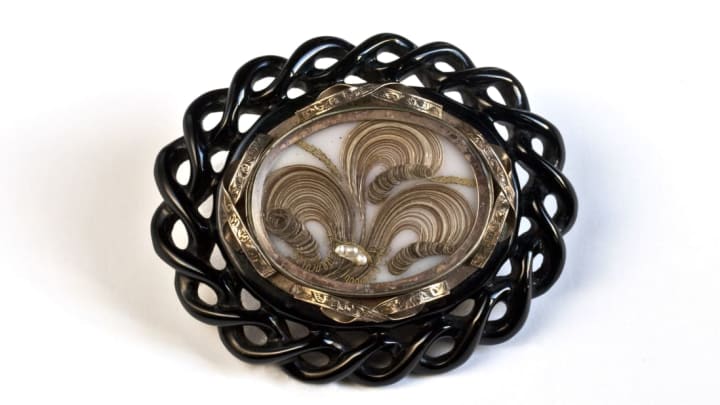During the Victorian era, hair wasn’t simply for heads. People wove clipped locks into elaborate accessories, encased them in frames and lockets, and used them to make wreaths, paintings, and other items. "Woven Strands," a new exhibition at Philadelphia’s Mütter Museum, explores this historical practice by featuring dozens of intricate works culled from five private collections.
According to Emily Snedden Yates, special projects manager at the Mütter Museum, hair work—as it’s called today—was common in England and America between the 17th and early 20th centuries. The popularity of the practice peaked in the 19th century, thanks in part to Queen Victoria’s prolonged public mourning after her husband Prince Albert’s death in 1861. People in both the UK and U.S. responded to her grief, with the latter country also facing staggering death tolls from the Civil War.
With loss of life at the forefront of public consciousness, elaborate mourning customs developed in both nations, and hair work became part of the culture of bereavement. "[The 19th century was] such a sentimental age, and hair is about sentiment," exhibition co-curator Evan Michelson tells Mental Floss. That sentimental quality made hair work fit for both mourning practices as well as for romantic or familiar displays of fondness.

Most hair artworks were made by women, and created solely for the domestic sphere or as wearable trinkets. Women relied on multiple techniques to create these objects, fashioning wreaths with hair-wrapped bendable wires—a process called gimp work—and dissolving ground hair into pigments used to paint images of weeping willows, urns, and grave sites. Watch fobs, necklaces, and bracelets were woven using an approach called table work, which involved anchoring hair filaments with lead weights onto a table and using tools to twist them into intricate patterns through a hole in the furniture’s surface. Yet another technique, palette work, involved stenciled sheets of hair that were cut into various shapes and patterns.
Hair work remained popular until World War I, according to Michelson, who co-owns New York City's quirky Obscura Antiques and Oddities shop and organized "Woven Strands" along with 19th century decorative arts expert John Whitenight.
“Women hit the workforce, and death occurred on such a huge scale that it really swept away the old way of mourning and the old way of doing things,” Michelson says. By the early 20th century, tastes and aesthetics had also changed, with hair work beginning to be viewed “as something grandma had,” she explains.
The Mütter’s exhibition aside, people typically won’t see hair work in major museums. Being a craft primarily performed by women at home, hair works were usually passed down in families and often viewed as worthless from a financial and artistic perspective.
“A lot of hair work was discarded,” Michelson says. Many owners repurposed the shadowbox frames often used to display hair work by removing and tossing the artworks within. Works stored in basements and attics also frequently succumbed to water damage and insects. Antique dealers today typically only see hair jewelry, which often featured semi-precious materials or was encased in a protective layer.

Yet examples of hair wreaths, palette work, and other delicate heirlooms do occasionally surface. They’re prized by a small group of avid collectors, even though other connoisseurs can be grossed out by them.
“People have this visceral reaction to it,” Michelson says. “They either gasp and adore it—like ‘I can’t get over how amazing it is’—or they just back away. There are very few other things where people are repulsed like this … In the 19th century no one batted an eyelash.”
“It’s a personal textile,” Snedden Yates explains. “It’s kind of like bone in that it doesn’t really decompose at the same rate as the rest of our bodies do. It’s not made of tissue, so if you keep it in the right environment it can be maintained indefinitely.”

“Woven Strands” features examples of gimp work, palette work, table work, and dissolved hair work. It’s often hard to trace these types of artworks back to their original creators—they typically don’t bear signatures—but the curators “really wanted to find hair that you could connect to an actual human being,” Michelson says. “We chose pieces that have provenance. We know where they came from or when it was made, or who actually donated the hair in some cases, or what the family name was. We also picked out things that are unusual, that you don’t see often—oddities, if you will.”

Displayed in the Mütter Museum’s Thomson Gallery, “Woven Strands” opens on January 19, 2018, and runs through July 12, 2018. On April 7, 2018, master jeweler and art historian Karen Bachmann will lead a 19th century hair art workshop, followed by a day-long historical symposium on the art on Sunday, April 8.
Michelson hopes that “Woven Strands” will teach future generations about hair art, and open their minds to a craft they might have otherwise dismissed as parochial or, well, weird. “We hope that people see it and fall in love with it,” she says.
